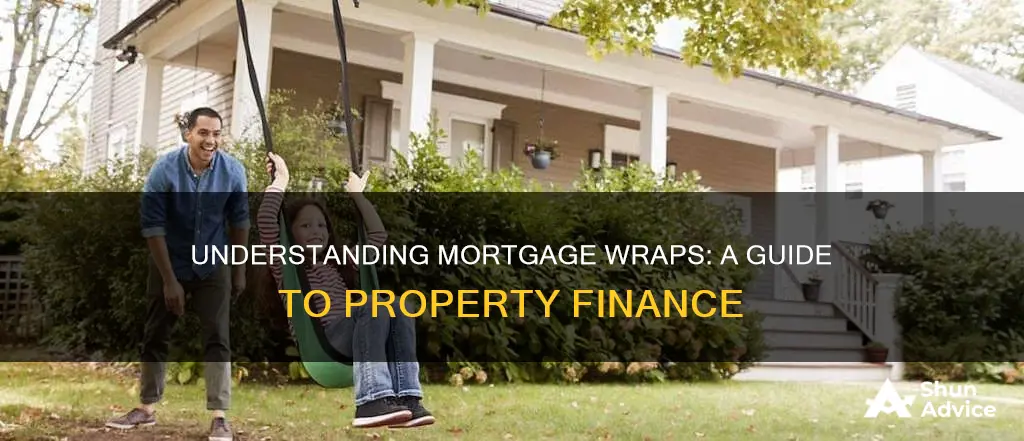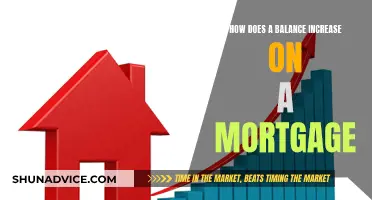
A wraparound mortgage, also known as a mortgage wrap, is a special form of seller financing that does not involve a conventional bank mortgage. It is a unique alternative to the traditional property sale process, where the seller keeps their existing mortgage and offers financing to the buyer, who then signs a mortgage with the seller. The buyer pays the seller a monthly payment, who then uses the proceeds to pay the original mortgage. This type of arrangement can benefit both buyers and sellers, but it also comes with certain risks and complexities that should be carefully considered.
Characteristics and Values of a Mortgage Wrap
| Characteristics | Values |
|---|---|
| Type | A special form of seller financing |
| Lender | The seller becomes the lender |
| Risk | The seller assumes all the risks and responsibilities of a traditional mortgage lender |
| Interest rate | The interest rate charged to the buyer is typically higher than the original rate charged to the seller by the bank |
| Profit | The seller pockets the difference between the two interest rates |
| Lien position | Wraparound mortgages are in a junior or second lien position |
| Foreclosure | If the buyer stops making payments, the seller must cover their original mortgage payment or risk mortgage default and foreclosure |
| Qualifications | It can be easier for home buyers to qualify for wraparound loans because they typically have more flexible requirements |
| Closing costs | Buyers may be able to avoid some fees a traditional lender would likely charge |
| Pool of buyers | For sellers finding it difficult to sell their homes, seller financing offers the opportunity to reach more buyers |
What You'll Learn

The seller becomes the lender
In a wraparound mortgage, the seller becomes the lender. This means that the seller offers financing to the borrower to buy the property. The buyer pays the seller monthly payments, which the seller then uses to pay off their original mortgage. The interest rate charged to the buyer is typically higher than the original rate charged to the seller, allowing the seller to profit from the difference.
Wraparound mortgages are a form of seller financing, where the buyer signs a mortgage with the seller, who takes the place of a conventional bank mortgage lender. The seller keeps their existing mortgage and enters a new mortgage agreement with the buyer to finance the purchase of the home. The buyer and seller agree on a down payment and loan amount, and the seller transfers the title and deed to the buyer. The seller then becomes the lender, collecting payments from the buyer each month to ensure the existing mortgage is paid.
Wraparound mortgages can benefit both buyers and sellers. Buyers may find it easier to qualify for a wraparound loan due to more flexible requirements, and they may also avoid certain fees that a traditional lender would charge. Sellers can profit from the difference in interest rates and may be able to sell their homes more easily to a larger pool of buyers.
However, there are risks for both parties. Buyers may end up paying a higher interest rate than with a traditional mortgage. Sellers take on the full default risk on the loan, and if the buyer stops making payments, the seller must continue to pay their original mortgage or risk default. It is important for both parties to carefully consider these risks and work with a real estate attorney to guide them through the process.
Researching Mortgages: A Step-by-Step Guide to Getting Started
You may want to see also

The buyer's monthly payments
In a wraparound mortgage, the buyer makes monthly payments directly to the seller, who then uses a portion of the funds to pay off their original mortgage. The interest rate charged to the buyer is typically higher than the original rate charged to the seller, allowing the seller to profit from the rate difference. For example, a seller with a mortgage rate of 6% may sell the property at a rate of 8% on a wraparound mortgage, earning a 2% spread on the monthly payments.
To ensure timely payment of the original mortgage, buyers should consider including a clause in the wraparound agreement that allows them to make payments directly to the seller's original lender. This reduces the risk of foreclosure if the seller fails to make payments. Additionally, buyers can benefit from wraparound mortgages by qualifying for homeownership even with lower credit scores or limited funds for closing costs.
While the buyer's monthly payments in a wraparound mortgage are crucial, it is important to consider the potential risks and complexities associated with this arrangement. Buyers should carefully review the terms and consult with experienced real estate attorneys to understand their obligations and protect their interests.
Overall, the buyer's monthly payments in a wraparound mortgage are a critical component of this financing arrangement. They involve direct payments to the seller, who then uses a portion to pay off their original mortgage, with the potential for profit due to the higher interest rate charged to the buyer.
Valuing Mortgage Servicing Rights: What You Need to Know
You may want to see also

The seller's risks and responsibilities
When it comes to a mortgage wrap, there are several risks and responsibilities that a seller should be aware of and carefully consider before proceeding. Firstly, one of the significant risks for the seller is the potential for default by the buyer. If the buyer fails to make the mortgage payments as agreed, the seller may face the risk of foreclosure. This could occur if the buyer encounters financial difficulties or decides to stop making payments. In such cases, the seller's credit score could be negatively impacted, making it challenging for them to obtain loans or favourable interest rates in the future.
To mitigate this risk, it is essential for the seller to thoroughly vet the buyer and ensure they have the financial capacity and stability to honour the mortgage wrap agreement. Conducting a comprehensive credit check, verifying employment and income, and reviewing the buyer's financial history can help assess their reliability and ability to make timely payments. It may also be prudent to include a clause in the contract that stipulates the consequences of late or missed payments, providing some recourse for the seller in the event of default.
Another important responsibility of the seller is to ensure full disclosure and transparency throughout the process. This includes providing the buyer with all relevant information regarding the property, the existing mortgage, and any other pertinent details. Failure to disclose necessary information could lead to legal repercussions and potential litigation. The seller should also be aware of any tax implications that may arise from the mortgage wrap transaction, as there could be capital gains tax or other tax liabilities that need to be addressed.
Additionally, the seller should carefully review and understand the terms and conditions of the existing mortgage before proceeding with a mortgage wrap. It is crucial to ensure that the existing mortgage allows for this type of arrangement and that there are no clauses that could cause issues or penalties down the line. The seller should also consider seeking legal advice to ensure that the mortgage wrap agreement is structured fairly and in compliance with all relevant laws and regulations.
Furthermore, it is essential for the seller to maintain their financial stability and liquidity during the mortgage wrap process. This includes continuing to make timely payments on the existing mortgage, as any missed or late payments could impact their creditworthiness and potentially jeopardise the agreement with the buyer. Proper financial planning and ensuring a stable source of income are crucial to mitigate this risk. By carefully considering these risks and responsibilities, the seller can make informed decisions and take the necessary steps to protect their interests and ensure a successful mortgage wrap transaction.
Exploring Mortgage Records: A Comprehensive Guide to Researching
You may want to see also

The wraparound mortgage foreclosure process
A wraparound mortgage is a type of junior loan that wraps or includes the current note due on the property. The wraparound loan consists of the balance of the original loan plus an amount to cover the new purchase price for the property. In this scenario, the seller offers financing to the buyer, who then purchases the property.
In the event of a foreclosure, the original lender has the right to take possession of the property. The wraparound mortgage is considered a junior lien, so the original mortgage takes priority in the event of default. The proceeds from the liquidation of the property will go towards paying off the original mortgage first, and any leftover funds will be distributed to the seller.
To prevent foreclosure, buyers should ensure they are able to meet the monthly payment obligations. Sellers, on the other hand, should carefully evaluate the buyer's financial situation and consider working with an experienced real estate attorney to guide them through the process and reduce their risk.
Finding the Best Mortgage: A Shopper's Guide
You may want to see also

Advantages and disadvantages
A wraparound mortgage is a unique form of seller financing in which the seller keeps their existing mortgage and extends a loan to the buyer. The buyer's mortgage "wraps around" the seller's existing loan on the property. The buyer makes monthly payments to the seller, who then makes their own regular repayments to the lender that financed the original loan.
Advantages
- Easier to qualify: Wraparound loans are often more accessible for buyers who cannot get approved for conventional financing due to credit issues or difficulty proving income. Sellers may be more flexible with loan requirements, and buyers do not have to qualify for a traditional mortgage.
- Potential for lower closing costs: Buyers may be able to avoid some fees typically associated with traditional mortgages, as they work directly with the seller.
- Profit potential for sellers: Sellers can profit from the difference between the rate on their existing mortgage and the buyer's new rate, as well as any appreciation in the home price.
- Larger pool of buyers for sellers: Wraparound mortgages can be an attractive option for buyers, increasing the pool of potential buyers for sellers, especially if their homes have been on the market for a long time.
- Simpler and cheaper transactions: Buyers may benefit from a simpler and faster process, avoiding a lender's long underwriting process and potentially reducing closing costs.
Disadvantages
- Risk of foreclosure: If the buyer stops making payments, the seller must continue making their original mortgage payments to avoid foreclosure. In the event of default, the original mortgage lender will be repaid first from the proceeds of a foreclosure sale, and the seller will only receive any leftover funds.
- Higher interest rates for buyers: Wraparound mortgages often have higher interest rates than conventional mortgages, resulting in larger monthly payments for buyers.
- Risk for sellers: While sellers can profit from the interest rate difference, they also take on the risk of the buyer defaulting on their payments.
- Not a common option: Wraparound mortgages are not a typical way to buy or sell a home, and other financing alternatives, such as FHA, USDA, or VA loans, may be more suitable for buyers and sellers.
Renegotiating Your Mortgage: Strategies for Success
You may want to see also
Frequently asked questions
A mortgage wrap, or wraparound mortgage, is a special form of seller financing. It provides property sellers and buyers with an alternative to the traditional property sale. In a wraparound mortgage, the seller keeps their existing mortgage and offers financing to the buyer to purchase the property. The buyer pays the seller a monthly payment, who then uses the proceeds to pay the original mortgage.
A mortgage wrap can be beneficial for both buyers and sellers. Buyers who cannot qualify for traditional loans from lenders can use wraps to facilitate a transaction. It is also a simpler, cheaper transaction as buyers won't have to wait through a lender's long underwriting process and may be spared many mortgage-related closing costs. For sellers, there is the potential for profit by charging a higher interest rate on the wrap than what they are paying on their existing mortgage.
A mortgage wrap can be complicated to set up and involves risks for both parties. The seller assumes all the risks and responsibilities of a traditional mortgage lender. If the buyer stops making monthly payments, the seller must still cover their original mortgage payment or risk default. The buyer also faces risks as the seller's lender can foreclose on the home if the seller doesn't make their mortgage payments, even if the buyer is making their payments on time.







